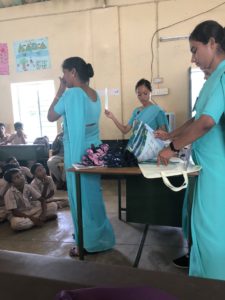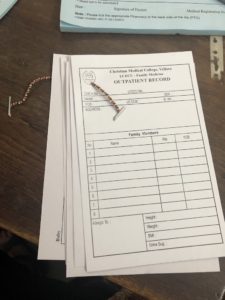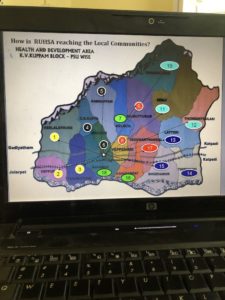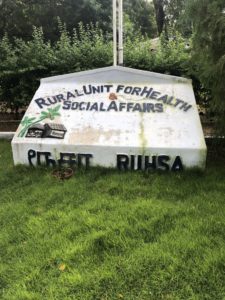Week 2
November 12th, 2019 by Kimberly Hall
What a learning week!!
I was back in Kilminnel to start the week. One of my favorite aspects of this particular clinic is that there is a geriatric club. The elders (60+) of the community gather, one reads the daily paper to everyone, they play games, we lead them in range of motion exercises and provide a nutritious snack. A couple other clinics offer this as well. It is fun to see the elders interact and build a community. Some live with their children and others live alone and the program is meant to combat depression and make check up visits easy.
Another program the nurses started in the community is school visits with different educational topics about every month and I was able to observe the Masters students do a presentation at the school. One of the Masters students did her thesis on transportation safety in India so she led this lesson. She covered travel and road safety and had handmade picture cards for the students to view. So they reviewed road signs, how to wear a helmet, not to use your phone while bicycling etc. the children were primary school students from several classes. After the kids wanted to hear who I was and why I am in India. They all said very enthusiastic goodbyes! A similar program occurs at the weekly morbidity clinics, where sometimes 100+ patients come through the clinic, and the nurses prepare a skit or song or presentation to deliver before the clinic starts and patients fill every corner of the clinic.


School presentation & pre-clinic skit
I visited the Kannigapuram Outreach Clinic which is just outside Vellore. This campus is very close to where CMC is building a massive new hospital. Apparently, the community members were upset that the building of the hospital would use their resources (water etc) and protested that they should be given a free clinic that also would provide jobs for community members. So, CMC rents a home that they have turned into the Kannigapuram Clinic. The clinic is not free for everyone, but if the patients are in a certain socioeconomic class, the care is free. This clinic is different from the community clinics and is a place patients are often referred to from Kilminnel, Pattutakku etc. It is closer than the hospitals and offers more services. There is a pharmacist and physician on site. The more basic clinics have some meds and dressings etc, but this clinic has many more. The nurse run clinics are meant for monitoring and the first step for patients to get guidance. The pharmacist, receptionist and physician all have computers for charting, while the smaller community clinics record on paper.

Outpatient record…patient brings with them to each visit!
I also spent a day at RUHSA or the Rural Unit for Health and Social Affairs. Wow. The things they are doing in this rural community are amazing. The communities I have been going to are rural, but closer to a bigger city than RUHSA. In essence RUHSA provides level 1 & 2 care and actively combats social determinants of health. There are 23 outreach clinics across 18 communities and the inpatient + outpatient facility. They have education programs that cover the lifespan, a community college on campus that provides vocational education at a reduced rate and provide targeted education during school years. For example, they took a poll at the local school of all girls in their early teen years asking what things they would like answers to that they do not feel are covered at work/home. The top 3 answers were their menstrual cycle and feminine health, “how to handle the opposite sex” (do we actually know the answer to this?!) and how to apply for college/what careers are available. So educational sessions and resources were provided on the female reproductive cycle, managing interpersonal relationships and college workshops. Due to cultural beliefs in the area, one parent was required to attend the college informational meeting to help reduce pressure and bias to choose a certain profession from the parent based on outdated or misinformation. The program was so outrageously popularl the school requested that the same be done for males as well. What an opportunity for health education! They also have self-help groups for women which teach about proper financial management and provide 0% interest loans. I can’t remember the rest, but they have many awesome programs that are showing measurable results.
I was able to observe inpatient rounds and saw several perplexing cases as well as many “typical” cases for this area (COPD, diabetic complications, work related injury). I also toured and sat in on outpatient, PT and ophthalmology appointments. Different specialists come in from the main hospital on different days and today ENT was present. It was a very busy, encouraging and enlightening day!


Map of RUHSA’s clinics
I provided a presentation on the basics of global health this week as well. I am in KU’s global health course and since I am doing my DNP project looking at international scope of practice for NPs, they really wanted to hear more. I feel like I am still learning a lot, but it went well! They are knowledgeable on the sustainable development goals and social determinants of health, but we had a healthy discussion about the differences in these between the USA and India. We also had a wonderful talk about culturally competent care including scenarios where we may have personal bias, what that can look like and how we overcome it to provide the best care. Primary care is often not as glamorous as a lifesaving surgery or treating a superbug, and we discussed the struggles with nurse recruitment and the potential impact of improved preventive health measures.
I was overwhelmed with knowledge and had a wonderful week!!


Sorry, comments for this entry are closed at this time.